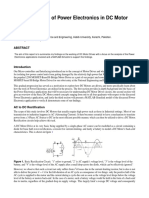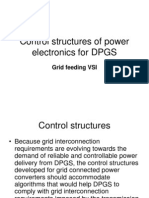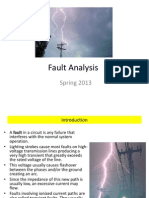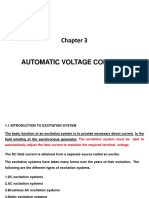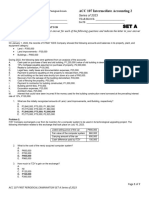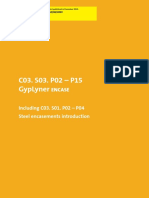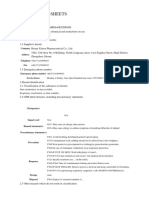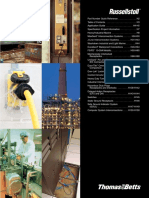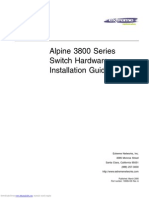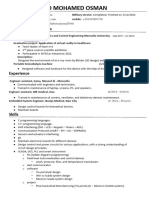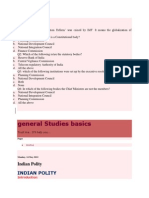DC Motors Speed Control - Mod
DC Motors Speed Control - Mod
Uploaded by
Anuja VargheseCopyright:
Available Formats
DC Motors Speed Control - Mod
DC Motors Speed Control - Mod
Uploaded by
Anuja VargheseOriginal Description:
Original Title
Copyright
Available Formats
Share this document
Did you find this document useful?
Is this content inappropriate?
Copyright:
Available Formats
DC Motors Speed Control - Mod
DC Motors Speed Control - Mod
Uploaded by
Anuja VargheseCopyright:
Available Formats
Solid State Devices Speed Control
MTE 320
Spring 2006
E.F. EL-Saadany
Solid State Devices Speed Control of DC Motors
1. Basics of DC Motors Speed Control
Since E a = Vt I a Ra and E a = K a m , Therefore, m =
Vt I a Ra . K a
Practically, speed control of DC motors can be fulfilled using on of two methods: Field Control: by varying the field current. This can be achieved by varying the field voltage. Voltage Control: by varying the armature terminal voltage.
Up to the rated (base) speed (the speed corresponding to rated operation condition, rated armature voltage, rated armature current, and rated field current), the armature and the field currents are kept constant to maintain the torque at its rated value. The speed control within this range is carried out by varying the armature voltage. Beyond the base speed, the speed control the achieved by varying the field current. Within this range, the motor power is maintained constant and the torque is reduced with the increase in the rotational speed as shown in Fig. 1. For series motor, the speed control beyond the base speed is carried out using the armature current variation (since the armature and the field current are the same in series motors) as shown in Fig. 2.
Fig. 1 Speed control characteristic of separately excited DC motors [1] 1
Solid State Devices Speed Control
MTE 320
Spring 2006
E.F. EL-Saadany
Fig. 2 Speed control characteristic of series DC motors [1]
2. Speed Control using Power Semiconductor Switches
As discussed in previous lectures, there are several power semiconductor switches configuration that can be used to provide variable output DC voltage. Single and three-phase AC-to-DC converters (rectifiers) can be used to vary the input armature voltage and / or the field voltage of DC machines to control it speed of rotation as shown in Fig. 3-a. Moreover, DC-to-DC converters can also be used for speed control as shown in Fig. 3-b. the following subsections will briefly discuss some example of the used power semiconductor converters in the speed control of DC motors.
Fig. 3 Power seimconductor converters for DC motors speed control[1]
Solid State Devices Speed Control
MTE 320
Spring 2006
E.F. EL-Saadany
2.1 Single-Phase Rectifiers In these configurations, the armature and / or the field winding voltage can be varied using singlephase full bridge AC-to-DC converters as shown in Fig. 4-a. This is a two quadrant converter, as shown in Fig. 4-b, where the load current is always positive while the load voltage may be positive or negative. The generated waveforms are shown in Fig. 4-c. Single-phase AC-to-DC semi-converters can be also used for DC motors speed control as shown in Fig. 5-a. However, this is a first-quadrant converter, as shown in Fig. 5-b, where the load current and voltage are always positive. The generated waveforms are shown in Fig. 5-c. Usually the same AC supply is used as an input for the two converters. The average value of the armature and / or field voltage (and hence the rotational speed) can be varied and controlled by varying the firing angle of the thyristors used. The equation relating the armature and the field voltage with the supply voltage and the firing angle can be expressed as follows,
Fig. 4 DC motor speed control using single-phase full converters [1]
For single-phase full converters connected to the armature terminals: The average value (DC) of the armature voltage is,
Va =
2 Vm
cos ( a )
for 0 a
where Va is the average value of the armature voltage, Vm is the maximum value of the supply voltage, and a is the armature converters thyristor firing (delay) angle.
Solid State Devices Speed Control
MTE 320
Spring 2006
E.F. EL-Saadany
For single-phase full converters connected to the field terminals:
The average value (DC) of the field voltage is, Vf = 2 Vm
cos f
( )
for 0 f
where Vf is the average value of the field voltage, and f is the field converters thyristor firing (delay) angle.
Fig. 5 DC motor speed control using single-phase semi-converters [1]
For single-phase semi-converters connected to the armature terminals:
The average value (DC) of the armature voltage is, Va = Vm
(1 + cos ( a ))
for 0 a
For single-phase semi-converters connected to the field terminals:
The average value (DC) of the field voltage is, Vf = Vm
(1 + cos ( f ))
for 0 f
2.2 DC Choppers
In these configurations, the armature and / or the field winding voltage can be varied using DC-to-DC converters as shown in Fig. 6-a. The input DC voltage can be generated using uncontrolled rectifier
Solid State Devices Speed Control
MTE 320
Spring 2006
E.F. EL-Saadany
circuits. This is a first-quadrant converter as shown in Fig. 6-b. The associated waveforms are given in Fig. 6-c. The average value of the armature and / or field voltage (and hence the rotational speed) can be varied and controlled by varying the duty cycle of power semi-conductor device used. The equation relating the armature and the field voltage with the supply voltage and the firing angle can be expressed as follows,
Fig. 6 DC motor speed control using first quadrant DC-to-DC converters [1]
The average value for the armature voltage is,
Va = k Vs
where Va is the average value of the armature voltage, Vs is the DC supply voltage (the average value of the output voltage of a AC-to-DC converter), and k is the choppers duty cycle.
The power supplied to the motor is,
Pi = Va I a = k V s I a
where Pi is the supplied (input) power to the DC motor, Ia is the average value of the armature current.
Assuming losseless power converter, the input power to the DC motor is the source output power,
Ps = Pi
where Ps is the source output power.
Solid State Devices Speed Control
MTE 320
Spring 2006
E.F. EL-Saadany
The average value for the input current is,
Is = k Ia
where Is is the average value of the input current. The equivalent input resistance of the DC chopper as seen by the supply is given by,
Req = Vs V = s Is k Ia
where Is is the average value of the input current.
3. Numerical Examples
Example 1: A separately excited DC motor is controlled using single-phase AC-to-DC semi-
converters connected to its armature and field terminals as shown in Fig 7. The AC supply connected to the armature and field semi-converters is a single-phase, 208 V, 60 Hz, AC source. The armature and field resistances are 0.25 and 147 , respectively. The motor voltage constant is 0.7032 V/A rad/s. The field current is set to its maximum possible value. The armature and the field currents are assumed continuous and ripple free. If the load torque is 45 N.m. at 1000 rpm, calculate 1. The field current, 2. The armature current, and
3. The delay angle for the thyristors in the armature converter. Vs = 208 V, f = 60 Hz, If = max, Ra = 0.25 , Rf = 147 , kv = 0.7032 V/A rad/s, TL = 45 N.m., and n = 1000 rpm.
Solution:
Given:
For separately excited DC motor is controlled using single-phase AC-to-DC semiconverters shown in Fig. 7.
1. The average value for the field voltage is, Vf = Vm
(1 + cos ( f ))
The average value for the field current is
Solid State Devices Speed Control
MTE 320
Spring 2006
E.F. EL-Saadany
If =
Vf Rf
V f 1 + cos f Rf
( ))
Fig. 7 DC motor speed control using single-phase semi-converters [1] Therefore, the field current will maintain its maximum possible value if f = 0.
V f , max =
208 2
V f , max Rf
(1 + cos (0)) = 187.27
V , and
The maximum possible value for the field current is, I f , max = = 187.27 = 1.274 147 A
2. The developed (load) torque is given by,
Td = K a I a = K v I f I a
Therefore, the armature current is,
Ia = Td 45 = = 50.23 Kv I f 0.7032 x 1.274 A
3. The armature back emf is E a = K a m = K v I f m = 0.7032 x 1.274 x 2 x 1000 = 93.82 V 60
Q E a = V a I a Ra
Solid State Devices Speed Control
MTE 320
Spring 2006
E.F. EL-Saadany
Va = E a + I a Ra = 93.82 + 50.23 x 0.25 = 106.38 V
However, the average value of the armature voltage is related to the delay angle of the armatures converter by,
Va = Vm
(1 + cos ( a ))
Va
Vm 1 =
cos ( a ) =
x 106.38
208 2
1 = 0.136
a = 82.18
Example 2: A separately excited DC motor is controlled using a DC-to-DC converter as shown
in Fig 8. The DC supply used is a 600 V source. The armature resistance is 0.05 . The constant for the back emf is 1.527 V/A rad/s. The armature current is set to 250 A and is continuous and ripple free. The field current is set to 2.5 A. If the operating duty cycle of the DC-to-Dc converter is 60 %. Calculate 1. The input power from the DC supply, 2. The motor speed, 3. The developed torque, and 4. The input equivalent resistance as seen by the DC supply. Vs = 600 V, Ia = 250 A, Ra = 0.05 , If = 2.5 A, kv = 1.527 V/A rad/s and k = 60 %. For separately excited DC motor is controlled using a DC-to-DC converter shown in Fig. 8. 1. The input power from the DC supply is,
Pi = Va I a = k V s I a = 0.6 x 600 x 250 = 90,000 W = 90 kW
Given: Solution:
2. The average value for the armature voltage is,
Va = k V s = 0.6 x 600 = 360 V
The armature back emf is
E g = Va I a Ra = 360 250 x 0.05 = 347.5 V
Solid State Devices Speed Control
MTE 320
Spring 2006
E.F. EL-Saadany
Fig. 8 DC motor speed control using first quadrant DC-to-DC converters [1]
The motor rotational speed can be determined using the following relation,
E g = K a m = K v I f m m = Eg Kv I f =
347.5 = 91.028 rad / s 1.527 x 2.5
3. The developed torque is given by,
Td = K a I a = K v I f I a = 1.527 x 2.5 x 250 = 954.375 N .m.
4. The input equivalent resistance as seen by the DC supply is given by,
Req = Vs V 600 = s = =4 I s k I a 0.6 x 250
References
[1] Muhammad H. Rashid, Power Electronics, Third Edition, Pearson Prentice Hall, NJ, USA, 2004. [2] Theodore Wildi, "Electrical Machines Drives, and Power Systems," Prentice Hall, Ohio, 2006.
You might also like
- Assig 1Document4 pagesAssig 1atharvaNo ratings yet
- Industrial Drives and ControlsDocument4 pagesIndustrial Drives and ControlsMohit SanandiyaNo ratings yet
- DC Motor Speed Control Methods Using MATLAB - Simulink and Their Integration Into Undergraduate Electric Machinery CoursesDocument9 pagesDC Motor Speed Control Methods Using MATLAB - Simulink and Their Integration Into Undergraduate Electric Machinery CoursesWen ZJNo ratings yet
- Vector Control of AC Induction MotorDocument7 pagesVector Control of AC Induction MotorAli H. NumanNo ratings yet
- 16 MarksDocument4 pages16 MarksAnand RamanNo ratings yet
- PE Lecture No.08 PDFDocument15 pagesPE Lecture No.08 PDFmonish halder100% (2)
- Steady-State Analysis of DC MotorsDocument24 pagesSteady-State Analysis of DC MotorsUsama RaoNo ratings yet
- DC Drives PDFDocument90 pagesDC Drives PDFkeerthi50% (2)
- Design of Electrical Circuits using Engineering Software ToolsFrom EverandDesign of Electrical Circuits using Engineering Software ToolsNo ratings yet
- Simulation of Some Power Electronics Case Studies in Matlab Simpowersystem BlocksetFrom EverandSimulation of Some Power Electronics Case Studies in Matlab Simpowersystem BlocksetNo ratings yet
- DC Motor ModelingDocument2 pagesDC Motor Modelingkakavietnam9No ratings yet
- Power Electronics Application in DC Motor Drives - Case Study - ss03595 - Sarwan Shah PDFDocument6 pagesPower Electronics Application in DC Motor Drives - Case Study - ss03595 - Sarwan Shah PDFMehdi Raza KhorasaniNo ratings yet
- Microcontroller Based Constant Speed Low Cost Energy Efficient BLDC Motor Drive Using Proteus VSM SoftwareDocument7 pagesMicrocontroller Based Constant Speed Low Cost Energy Efficient BLDC Motor Drive Using Proteus VSM SoftwaremakroumNo ratings yet
- Lab ReportDocument84 pagesLab ReportusmanzahidNo ratings yet
- Ee 331 Design - Servo MotorDocument5 pagesEe 331 Design - Servo MotorLa-Pierre O'MeallyNo ratings yet
- SIMULATION MODEL of Permanent Magnet Synchronous MotorDocument9 pagesSIMULATION MODEL of Permanent Magnet Synchronous MotorSri MathiNo ratings yet
- Lectures 6 & 7 - Uncontrolled (Diode) Rectifier Circuits: Single-Phase Center-Tapped RectifierDocument21 pagesLectures 6 & 7 - Uncontrolled (Diode) Rectifier Circuits: Single-Phase Center-Tapped RectifierTommy ManNo ratings yet
- Chapter 12Document23 pagesChapter 12sachin235No ratings yet
- Reference Frame Theory PDFDocument42 pagesReference Frame Theory PDFSubaragavanNo ratings yet
- Induction Motor Braking Regenerative Dynamic Braking of Induction Motor - Electrical4u PDFDocument7 pagesInduction Motor Braking Regenerative Dynamic Braking of Induction Motor - Electrical4u PDFbalajiNo ratings yet
- r05410202 Power Semiconductor DrivesDocument7 pagesr05410202 Power Semiconductor DrivesandhracollegesNo ratings yet
- Vsi Csi With Various LoadsDocument56 pagesVsi Csi With Various LoadsDeependra RastogiNo ratings yet
- ED1000Document4 pagesED1000Mohamed TahounNo ratings yet
- Why Do Some Motors Have Constant Load Torque and Some Have Variable?Document5 pagesWhy Do Some Motors Have Constant Load Torque and Some Have Variable?Charles RobiansyahNo ratings yet
- An Serv 002 PDFDocument20 pagesAn Serv 002 PDFMario TapiaNo ratings yet
- Electrical Drives Notes Lecture 1Document4 pagesElectrical Drives Notes Lecture 1Kunal TanwarNo ratings yet
- Electric Machines and Drives 1st EditionDocument16 pagesElectric Machines and Drives 1st EditionBellaaNo ratings yet
- Retardation TestDocument5 pagesRetardation TestAnkit Shetty100% (1)
- DC Drives Numericals 2 PDFDocument20 pagesDC Drives Numericals 2 PDFADITYA DAS 17BEE0267No ratings yet
- Two Reaction Theory of Synchronous MachinesDocument15 pagesTwo Reaction Theory of Synchronous MachinesxernoxianNo ratings yet
- Power Analysis of PWM Motor Drives PDFDocument22 pagesPower Analysis of PWM Motor Drives PDFJaime Vanegas IriarteNo ratings yet
- Final PresentationDocument103 pagesFinal PresentationQasir NawazNo ratings yet
- Symmetrical Fault AnalysisDocument12 pagesSymmetrical Fault AnalysisHONAR DUHOKINo ratings yet
- Scalar Control of Ac DrivesDocument38 pagesScalar Control of Ac Drivessureshy-ee213No ratings yet
- Control System Lab ManualDocument62 pagesControl System Lab ManualVenkata Subramanian0% (1)
- EE360 - Synchronous MachinesDocument85 pagesEE360 - Synchronous MachinesAliAl-jaziri100% (1)
- Transient Response of Induction Machine Using MATLAB SimulinkDocument63 pagesTransient Response of Induction Machine Using MATLAB Simulinkجمال طيبيNo ratings yet
- Power Electronic Control of DC Motor DrivesDocument20 pagesPower Electronic Control of DC Motor DrivesThureinNo ratings yet
- Control Structures of Power Electronics For DPGSDocument23 pagesControl Structures of Power Electronics For DPGSAnna Maria BanicaNo ratings yet
- Speeed ControlDocument3 pagesSpeeed ControlChristine GomezNo ratings yet
- Four Quadrant OperationDocument9 pagesFour Quadrant OperationMOTILAL SUTHAR215291No ratings yet
- Advanced Power Electronics DC DC Converters: DR Taosif IqbalDocument71 pagesAdvanced Power Electronics DC DC Converters: DR Taosif IqbalTaosif IqbalNo ratings yet
- Unit V Design of Controllers For Drives: 3.1transfer Function For DC MotorDocument12 pagesUnit V Design of Controllers For Drives: 3.1transfer Function For DC Motormanoj kumarNo ratings yet
- Simulating An AC Motor DriveDocument26 pagesSimulating An AC Motor DriveplnegraoNo ratings yet
- Ups Kstar-1-3kva 120V 0.9PFDocument5 pagesUps Kstar-1-3kva 120V 0.9PFoscar mauricio caballero camachoNo ratings yet
- Ied Unit VDocument8 pagesIed Unit VRudra Kumar MishraNo ratings yet
- Symmetrical Fault Analysis PDFDocument16 pagesSymmetrical Fault Analysis PDFlimkokchiang809No ratings yet
- Electrical Basic and Classic ControlDocument177 pagesElectrical Basic and Classic ControlBudi Budi100% (2)
- Chapter 3 Voltage ControlDocument33 pagesChapter 3 Voltage ControlNaveen Reddy100% (2)
- Sns College of Technology Department of Eee: SVC-SVC InteractionDocument7 pagesSns College of Technology Department of Eee: SVC-SVC InteractionDejene BirileNo ratings yet
- Power System 2 Tute 4Document2 pagesPower System 2 Tute 4Hemant KumarNo ratings yet
- Servo MotorDocument17 pagesServo MotorAswathy SimonNo ratings yet
- 3 Point StarterDocument6 pages3 Point StartersuryavigneNo ratings yet
- Power System Stability - Unit 4 PSOCDocument57 pagesPower System Stability - Unit 4 PSOChareesh.makesuNo ratings yet
- Servo Motor SystemDocument8 pagesServo Motor SystemAnonymous Y7WZ3dqoXhNo ratings yet
- Improved Indirect Power Control (IDPC) of Wind Energy Conversion Systems (WECS)From EverandImproved Indirect Power Control (IDPC) of Wind Energy Conversion Systems (WECS)No ratings yet
- DcdrivesDocument17 pagesDcdrivesMogaka LucasNo ratings yet
- DC & AC DrivesDocument12 pagesDC & AC DrivesPKNo ratings yet
- Kontrola Brzine DC Motora Pomoću TiristoraDocument6 pagesKontrola Brzine DC Motora Pomoću TiristoraTHOMPSONvkNo ratings yet
- Guard - me@RRU PolicyDocument4 pagesGuard - me@RRU PolicyAdityaNo ratings yet
- ACMM - IMBA VII - Course OutlineDocument7 pagesACMM - IMBA VII - Course OutlineNishit KalawadiaNo ratings yet
- Debt MarketDocument14 pagesDebt MarketDivya KeswaniNo ratings yet
- PVP Siddhartha Institute of TechnologyDocument6 pagesPVP Siddhartha Institute of TechnologyAnduri SreenivasuluNo ratings yet
- Biman Bangladesh Airlines LTDDocument1 pageBiman Bangladesh Airlines LTDnkarimofficialNo ratings yet
- Guanghua Kellogg Executive Mba BrochureDocument17 pagesGuanghua Kellogg Executive Mba Brochuresingh.darshan9No ratings yet
- Acc107 p1 Exam Set A Answer KeyDocument9 pagesAcc107 p1 Exam Set A Answer KeyAndrea Vila VelascoNo ratings yet
- White Book C03 S03 Steel Encasements GypLyner ENCASEDocument20 pagesWhite Book C03 S03 Steel Encasements GypLyner ENCASEPavaloaie Marian ConstantinNo ratings yet
- Sustainability of A Beach Resort A Case Study-1Document6 pagesSustainability of A Beach Resort A Case Study-1abhinavsathishkumarNo ratings yet
- The Oas Gazette February 2024Document67 pagesThe Oas Gazette February 2024bighnarajmahakur9No ratings yet
- MSDS - Multivitamins + Dextrose - GOPRIME IVDocument5 pagesMSDS - Multivitamins + Dextrose - GOPRIME IVCJ BagadiongNo ratings yet
- Lab 3 Mikro P ReportDocument10 pagesLab 3 Mikro P ReportMuhammad AdnanNo ratings yet
- Homework 1 - Worksheet - Unit 3 - GB - Plans.Document3 pagesHomework 1 - Worksheet - Unit 3 - GB - Plans.Maria Edilma ParraNo ratings yet
- Lockheed Twin SeriesDocument17 pagesLockheed Twin SeriesGiora MinorNo ratings yet
- MBA-Nayak PPT 1Document15 pagesMBA-Nayak PPT 1Anveshak PardhiNo ratings yet
- Russellstoll (Thomas and Betts)Document151 pagesRussellstoll (Thomas and Betts)fabikduqueNo ratings yet
- 00307572Document3 pages00307572Ahmad syamsudin TabarokNo ratings yet
- List of Officers of Dipr Assam 1Document7 pagesList of Officers of Dipr Assam 1adityamduttaNo ratings yet
- Alpine 3800 Fm24mfiDocument66 pagesAlpine 3800 Fm24mfiGabriel GonzalezNo ratings yet
- EE3004Document1 pageEE3004ashishNo ratings yet
- Divestment ProgramDocument20 pagesDivestment ProgramChristina LunaNo ratings yet
- Hossam Emad Mohamed OsmanDocument2 pagesHossam Emad Mohamed Osmanho7318531No ratings yet
- 960GC-GS FXDocument5 pages960GC-GS FXwackypong143No ratings yet
- Stag MeasurmentDocument12 pagesStag MeasurmentRakesh ParaliyaNo ratings yet
- AppscDocument76 pagesAppscmurali42050% (2)
- ERA - Opinion NR BelgiumDocument29 pagesERA - Opinion NR BelgiumGuillermo Garcia HernandezNo ratings yet
- Cheat Sheet For ExamDocument2 pagesCheat Sheet For ExamJingchen ZhangNo ratings yet
- Lesson 7: Markup and Markdown Problems: Student OutcomesDocument4 pagesLesson 7: Markup and Markdown Problems: Student OutcomesJoan BalmesNo ratings yet
- Corporate GovernanceDocument41 pagesCorporate GovernanceHazelLouis100% (2)
- Acn 202Document8 pagesAcn 202Nadil HaqueNo ratings yet











